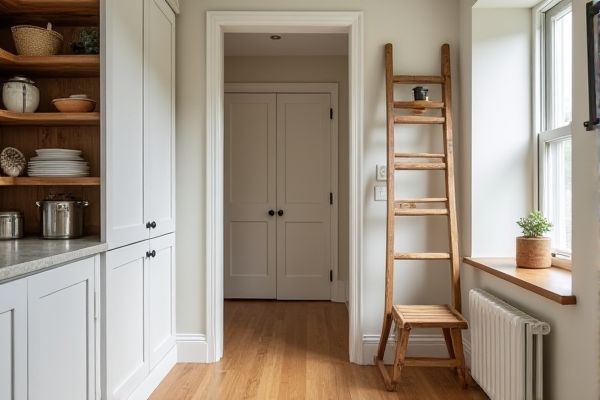
A pantry ladder offers a sturdy, specialized solution for reaching higher shelves with enhanced safety and style, while a step stool provides a compact, versatile option ideal for quick access to moderately elevated areas. Discover which choice best fits Your home needs by reading the rest of the article.
Table of Comparison
| Feature | Pantry Ladder | Step Stool |
|---|---|---|
| Purpose | Access high shelves in pantry or kitchen | Elevate to reach mid-height surfaces |
| Height | Taller, typically 3-6 feet | Shorter, usually 1-2 feet |
| Steps | Multiple wide steps | One or two steps |
| Design | Leaning or folding ladder style | Compact, foldable, or fixed stool |
| Weight Capacity | Higher, often 250-300 lbs | Lower, around 200-250 lbs |
| Storage | May require more space due to height | Compact and easy to store |
| Best Use | Kitchen pantry, tall cabinets | General household tasks |
Introduction: Pantry Ladder vs Step Stool
A pantry ladder offers extended height and stability, making it ideal for reaching high shelves in kitchens or storage rooms, while a step stool typically provides a lower platform best suited for accessing moderately elevated items. Pantry ladders often feature wider steps and a more robust design, enhancing safety and comfort during use. Step stools are more compact and portable, favored for their lightweight and ease of storage in smaller spaces.
Key Differences Between Pantry Ladders and Step Stools
Pantry ladders typically feature taller, more robust frames designed for easy access to high shelves, while step stools offer compact, lightweight portability ideal for quick, low-to-mid height tasks. Your choice depends on space and usage frequency, as pantry ladders provide greater stability and reach, whereas step stools prioritize convenience and storage efficiency. Safety features such as non-slip treads and sturdy handrails are more common on pantry ladders, enhancing security during extended use.
Space Considerations for Your Kitchen
A pantry ladder offers vertical storage efficiency, making it ideal for kitchens with high shelves and limited floor space. Step stools are more compact and easily stored, perfect for small kitchens where quick access is necessary without sacrificing room. Your choice depends on balancing available space with the frequency and height of your kitchen storage needs.
Safety Features and Stability Comparison
Pantry ladders typically feature wider steps with anti-slip surfaces and secure handrails, enhancing user stability during extended reach tasks. Step stools often have a compact design with rubberized feet to prevent slipping but may lack handrails, reducing support for balance. Overall, pantry ladders provide superior safety features and stability compared to step stools, making them better suited for frequent or higher elevation use in kitchen settings.
Weight Capacity and Durability
Pantry ladders typically offer higher weight capacity, often supporting up to 300 pounds, making them suitable for frequent use and heavier loads. Step stools generally have lower weight limits, around 200-250 pounds, but remain durable for everyday tasks. Your choice depends on whether you prioritize maximum durability and load-bearing for tasks like accessing high shelves or prefer a more compact, lighter option for occasional use.
Ease of Use and Accessibility
Pantry ladders offer greater ease of use with sturdy handrails and wider steps designed for stability, making it accessible for individuals needing extra support. Step stools, while more compact and lightweight, may lack the balance features that enhance user confidence when reaching higher shelves. Accessibility varies as pantry ladders typically accommodate multiple heights and provide safer grip options compared to the simple, often portable design of step stools.
Design and Aesthetic Appeal
Pantry ladders typically feature a classic wooden design with elegant finishes that enhance your kitchen's aesthetic, offering both functionality and a stylish statement piece. Step stools are often made from plastic or metal, emphasizing portability and simplicity but lacking the refined look of a pantry ladder. Your choice depends on whether you prioritize a timeless, decorative element or a compact, utilitarian tool for everyday kitchen tasks.
Storage Options and Convenience
A pantry ladder offers versatile storage options with built-in shelves or hooks, allowing you to keep your kitchen essentials organized while also providing easy access to high shelves. Step stools are generally more compact and easier to store, often folding for convenient placement in tight spaces but lack integrated storage features. Choosing between the two depends on your need for both accessibility and extra storage in your kitchen environment.
Price Comparison and Value for Money
Pantry ladders typically cost more than step stools due to their larger size and added stability features, with prices ranging from $50 to $150, compared to $20 to $60 for most step stools. The value for money depends on your needs; a pantry ladder offers better reach and safety for accessing higher shelves, making it a worthwhile investment for frequent use in kitchens or pantries. Your choice should balance budget constraints with practical benefits, ensuring you get reliable support without unnecessary expense.
Choosing the Right Option for Your Needs
Selecting the right option between a pantry ladder and a step stool depends on the height you need to reach and the type of stability required. A pantry ladder offers greater height and a sturdy design ideal for accessing high shelves, while a step stool provides portability and compact storage for quick, low-to-mid level tasks. Consider your space constraints, frequency of use, and the weight capacity needed to ensure your safety and convenience.
 homyna.com
homyna.com